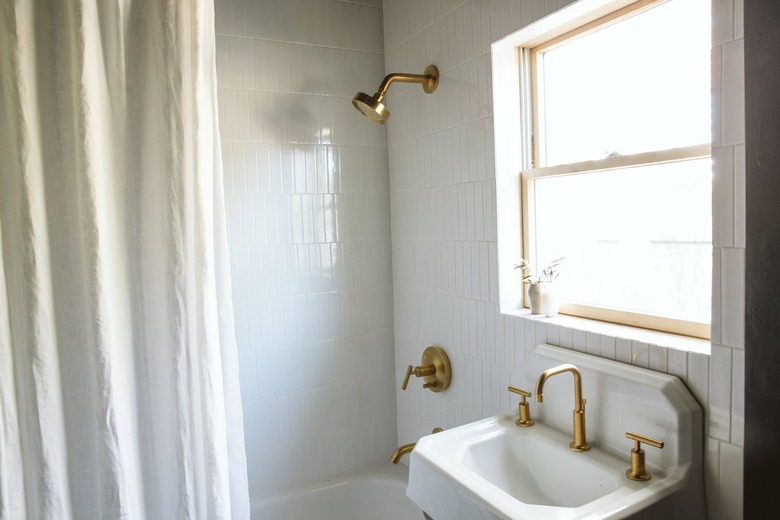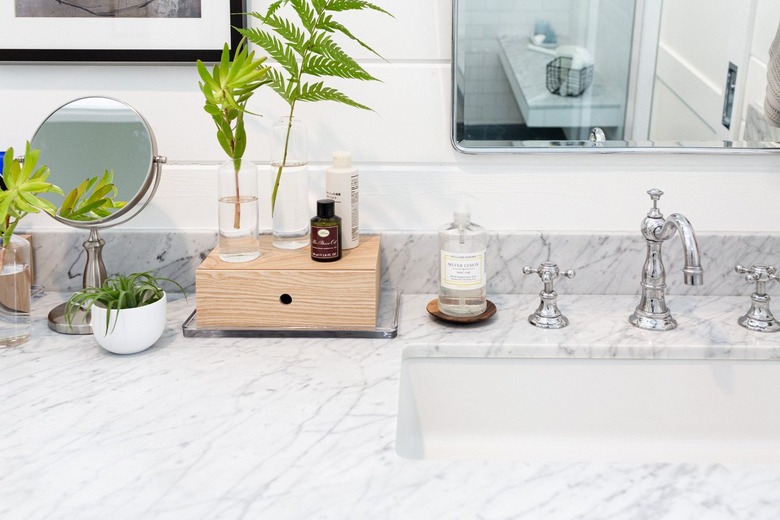What Are Water-Saving Bathroom Faucets?
The Environmental Protection Agency has a specific definition of water-saving bathroom faucets. Any faucet that delivers water at a maximum flow rate of 1.5 gallons per minute (gpm), which is 30 percent less than the standard flow rate of 2.2 gpm, can bear the EPA's WaterSense label on its box. According to the EPA, the United States could save billions of gallons of water per year if everyone replaced his conventional bathroom faucets with ones that bear the WaterSense label.
Tip
According to the EPA, a water-saving bathroom faucet is one that dispenses at a maximum flow rate of 1.5 gpm. This can be accomplished with a low-flow aerator or a metering mechanism that automatically shuts off the faucet after a preset time.
A Low-Flow Aerator Can Turn Any Faucet Into a Water-Saving One
A Low-Flow Aerator Can Turn Any Faucet Into a Water-Saving One
The easiest way to design water-saving bathroom faucets is to provide each one with a water-saving aerator. An aerator is a fitting that screws onto the faucet spout, and while its main purpose is to mix the outflowing water with air to create an oxygenated, laminar stream, it can also be designed to limit the water flow rate simply by having smaller and fewer holes than those on a conventional aerator.
Low-flow faucet aerators are readily available, and according to PlumbingSupply.com, they come in sizes and thread orientations that fit any style of bathroom faucet, and they are standard equipment on any WaterSense bathroom faucet. The water-saving bathroom sink faucet you purchase at your local home improvement outlet usually differs from a conventional faucet only by having a preinstalled water-saving aerator. By that same token, you can convert your existing faucet to a water-saving one simply by swapping the aerator. As long as the faucet delivers no more than 1.5 gpm, it merits a WaterSense label.
Metering Faucets Automatically Shut Off the Water
Metering Faucets Automatically Shut Off the Water
Another strategy to cut water use is to prevent the faucet from running when water isn't needed. Metering faucets, used primarily in commercial locations and public bathrooms where it's difficult to monitor usage, have a spring-loaded pushbutton or lever handle that automatically returns to the closed position.
The Moen M-PRESS lavatory faucet is an example that's designed for commercial use but can also be an attractive addition to a residential bathroom. It has a lever that is easy enough to push to make the faucet suitable for use in accessible bathrooms, and it delivers water at a rate of 0.5 gpm. This faucet also comes in double- and single-handle versions, and its valve and handle assembly can be retrofitted onto other select Moen faucets.
Hands-Free Water-Saving Bathroom Faucets
Hands-Free Water-Saving Bathroom Faucets
Hands-free, or touchless, faucets are the electronic version of metering faucets and are becoming increasingly common. A motion sensor located in the faucet body detects movement around the spout and automatically turns on the water, and when the movement stops, the faucet shuts off. This is a reliable way to ensure that the faucet runs only when water is actually needed. Some manufacturers even offer voice-activated faucets, although they are more common for kitchen use rather than bathroom use.
Costs Associated With Water-Saving Bathroom Faucets
Costs Associated With Water-Saving Bathroom Faucets
Faucets that employ high-tech water-saving technologies generally cost more than conventional faucets. A Moen M-PRESS costs about $200, whereas a conventional Moen bathroom faucet usually costs less than $100, and a touchless faucet can easily set you back $500 or more. If saving water is your main concern, pretty much any standard faucet fitted with a water-saving aerator will do. If you want to go the extra mile and limit your water usage to the minimum amount possible, you should be prepared for the extra cost, but you'll eventually make that up with reductions in your water bill.
As a water conservation method, some communities offer rebates when you replace your existing faucet with a water-saving model. The EPA publishes a directory of such communities on its WaterSense website. Check with your local water commission even if it isn't listed in the EPA directory to determine whether you qualify for one.

